Pedestrian Arching Mechanism at Bottleneck in Subway Transit Hub
Abstract
:1. Introduction
2. Building of Simulation Model
2.1. Comparison of Basic Model
2.2. Principle of Social Force Model
2.2.1. The Personal Desire Force
2.2.2. The Interaction Force
2.2.3. The Obstacles Forces
2.3. Movement Preference Characteristic in Subway Transit Hub
2.3.1. Desired Speed
2.3.2. Initial Speed
2.3.3. Pedestrian Diameter
3. Design of Pedestrian Experiment
3.1. Experiment Scenario
3.2. Pedestrian Volume
4. Analysis of Pedestrian Arching Mechanism
4.1. Description of Arching Phenomenon
4.2. Stage Division of the Arching Evolutionary
- (1)
- When the arching phenomenon is not occurred yet, pedestrian speed is higher at detection line 1 and 2. However, as the arching phenomenon occurred, pedestrian speed is decreased significantly at detection line 1 and 2. Then, speed is beginning to flatten.
- (2)
- At first, there are no pedestrians pass through detection line 3 and 4. Thus, pedestrian speed is 0 at detection line 3 and 4. With the emergence of the arching, a higher pedestrian speed occurred at detection line 3 and 4. As the arching stabilizes, pedestrian speed starts to stabilize at detection line 3 and 4.
- (3)
- The pedestrian speed at detection line 1 is slightly lower than pedestrian speed at detection line 2, indicating that the speed of the pedestrian crossing the bottleneck is higher than the speed at the entrance of the bottleneck.
- (4)
- The pedestrian speed at detection line 3 is higher than pedestrian speed at detection line 4, which is related to keep to the right in china traffic. This leads to pedestrian congestion at detection line 3 is more serious than at detection line 4.
4.3. Passing Time
5. Conclusions
Author Contributions
Funding
Data Availability Statement
Conflicts of Interest
References
- Shi, Z.; Zhang, N.; Zhu, L. Understanding the Propagation and Control Strategies of Congestion in Urban Rail Transit Based on Epidemiological Dynamics Model. Information 2019, 10, 258. [Google Scholar] [CrossRef] [Green Version]
- Helbing, D.; Farkas, I.; Vicsek, T. Simulating dynamical features of escape panic. Nature 2000, 407, 487–490. [Google Scholar] [CrossRef] [Green Version]
- Li, C.; Chi, G.; Jackson, R. Neighbourhood built environment and walking behaviours: Evidence from the rural American South. Indoor Built Environ. 2018, 27, 938–952. [Google Scholar] [CrossRef] [PubMed]
- Lei, W.; Tai, C.; Rong, C.; Qi, X.; Zhang, L.; Cong, J. Environmental parameters and analysis of crowd flow in an academic building of a university. Indoor Built Environ. 2021, 30, 39–55. [Google Scholar] [CrossRef]
- Daamen, W.; Hoogendoorn, S.P. Experimental Research of Pedestrian Walking Behavior. Transp. Res. Rec. J. Transp. Res. Board 2003, 1828, 20–30. [Google Scholar] [CrossRef] [Green Version]
- Hoogendoorn, S.P.; Daamen, W. Pedestrian Behavior at Bottlenecks. Transp. Sci. 2005, 39, 147–159. [Google Scholar] [CrossRef]
- Liu, X.; Song, W.; Zhang, J. Extraction and quantitative analysis of microscopic evacuation characteristics based on digital image processing. Phys. A Stat. Mech. Its Appl. 2009, 388, 2717–2726. [Google Scholar] [CrossRef]
- Seyfried, A.; Steffen, B.; Klingsch, W.; Lippert, T.; Boltes, M. The Fundamental Diagram of Pedestrian Movement Revisited—Empirical Results and Modelling. In Traffic and Granular Flow’05; Springer: Berlin/Heidelberg, Germany, 2007; pp. 305–314. [Google Scholar]
- Seyfried, A.; Passon, O.; Steffen, B.; Boltes, M.; Rupprecht, T.; Klingsch, W. New Insights into Pedestrian Flow Through Bottlenecks. Transp. Sci. 2009, 43, 395–406. [Google Scholar] [CrossRef]
- Tian, W.; Song, W.; Lu, W.; Fang, Z. Experiment and analysis on microscopic characteristics of pedestrian movement in building bottleneck. Sci. China Ser. E Technol. Sci. 2011, 54, 1730–1736. [Google Scholar] [CrossRef]
- Sun, L.; Luo, W.; Yao, L.; Qiu, S.; Rong, J. A comparative study of funnel shape bottlenecks in subway stations. Transp. Res. Part A: Policy Pr. 2017, 98, 14–27. [Google Scholar] [CrossRef]
- Luo, W.; Sun, L.S.; Yao, L.Y.; Gong, Q.; Rong, J. Experimental study for optimizing pedestrian flows at bottlenecks of subway stations. Promet Traffic Transp. 2018, 30, 525–538. [Google Scholar] [CrossRef]
- Guo, R.Y. Simulation of spatial and temporal separation of pedestrian counter flow through a bottleneck. Phys. A Stat. Mech. Appl. 2014, 415, 428–439. [Google Scholar] [CrossRef]
- Li, D.; Han, B. Behavioral effect on pedestrian evacuation simulation using cellular automata. Saf. Sci. 2015, 80, 41–55. [Google Scholar] [CrossRef]
- Tang, M.; Jia, H.; Ran, B.; Li, J. Analysis of the pedestrian arching at bottleneck based on a bypassing behavior model. Phys. A Stat. Mech. Its Appl. 2016, 453, 242–258. [Google Scholar] [CrossRef]
- Li, N.; Guo, R.Y. Simulation of bi-directional pedestrian flow through a bottleneck: Cell transmission model. Phys. A Stat. Mech. Appl. 2020, 555, 124542. [Google Scholar] [CrossRef]
- Li, Z.H.; Xu, W.T. Pedestrian evacuation within limited-space buildings based on different exit design schemes. Saf. Sci. 2020, 124, 104575. [Google Scholar] [CrossRef]
- Helbing, D.; Molnár, P. Social force model for pedestrian dynamics. Phys. Rev. E 1995, 51, 4282–4286. [Google Scholar] [CrossRef] [Green Version]
- Xu, S.; Duh, H.B.-L. A Simulation of Bonding Effects and Their Impacts on Pedestrian Dynamics. IEEE Trans. Intell. Transp. Syst. 2009, 11, 153–161. [Google Scholar]
- Yuen, J.; Lee, E. The effect of overtaking behavior on unidirectional pedestrian flow. Saf. Sci. 2012, 50, 1704–1714. [Google Scholar] [CrossRef]
- Wang, L.; Zheng, J.-H.; Zhang, X.-S.; Zhang, J.-L.; Wang, Q.-Z.; Zhang, Q. Pedestrians’ behavior in emergency evacuation: Modeling and simulation. Chin. Phys. B 2016, 25, 118901. [Google Scholar] [CrossRef]
- Kolivand, H.; Rahim, M.S.; Sunar, M.S.; Fata, A.Z.A.; Wren, C. An integration of enhanced social force and crowd control models for high-density crowd simulation. Neural Comput. Appl. 2020, 2020, 1–23. [Google Scholar] [CrossRef]
- Yang, X.; Yang, X.; Pan, F.; Kang, Y.; Zhang, J. The effect of passenger attributes on alighting and boarding efficiency based on social force model. Phys. A Stat. Mech. Appl. 2021, 565, 125566. [Google Scholar] [CrossRef]
- Zhou, R.; Cui, Y.; Wang, Y.; Jiang, J. A modified social force model with different categories of pedestrians for subway station evacuation. Tunn. Undergr. Space Technol. 2021, 110, 103837. [Google Scholar] [CrossRef]
- Yang, Z.F. Study on Characteristic of High Density Pedestrian Conflict Behavior in Subway Transit Hub; Beijing University of Technology: Beijing, China, 2014. [Google Scholar]
- Henderson, L.F.; Lyons, D.J. Sexual differences in human crowds motion. Nature 1972, 240, 353–355. [Google Scholar] [CrossRef] [PubMed]
- Li, D.; Han, B. Pedestrian Traffic; China Communication Press: Beijing, China, 2011. [Google Scholar]
- Transit Cooperative Research Program (TCRP). Transit Capacity and Quality of Service Manual; Transportation Research Board: Washington, DC, USA, 2003; Volume 7, pp. 23–67. [Google Scholar]
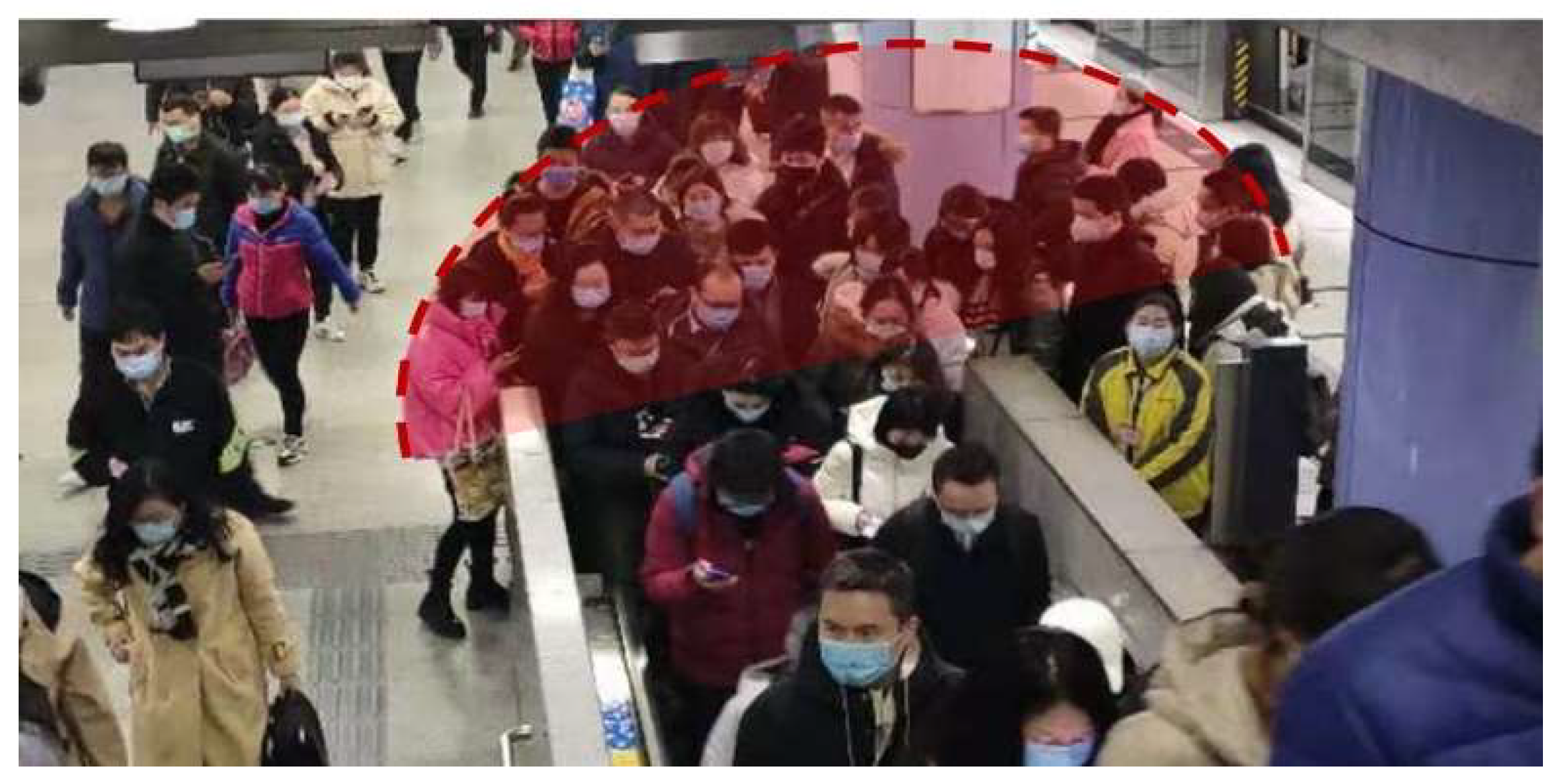

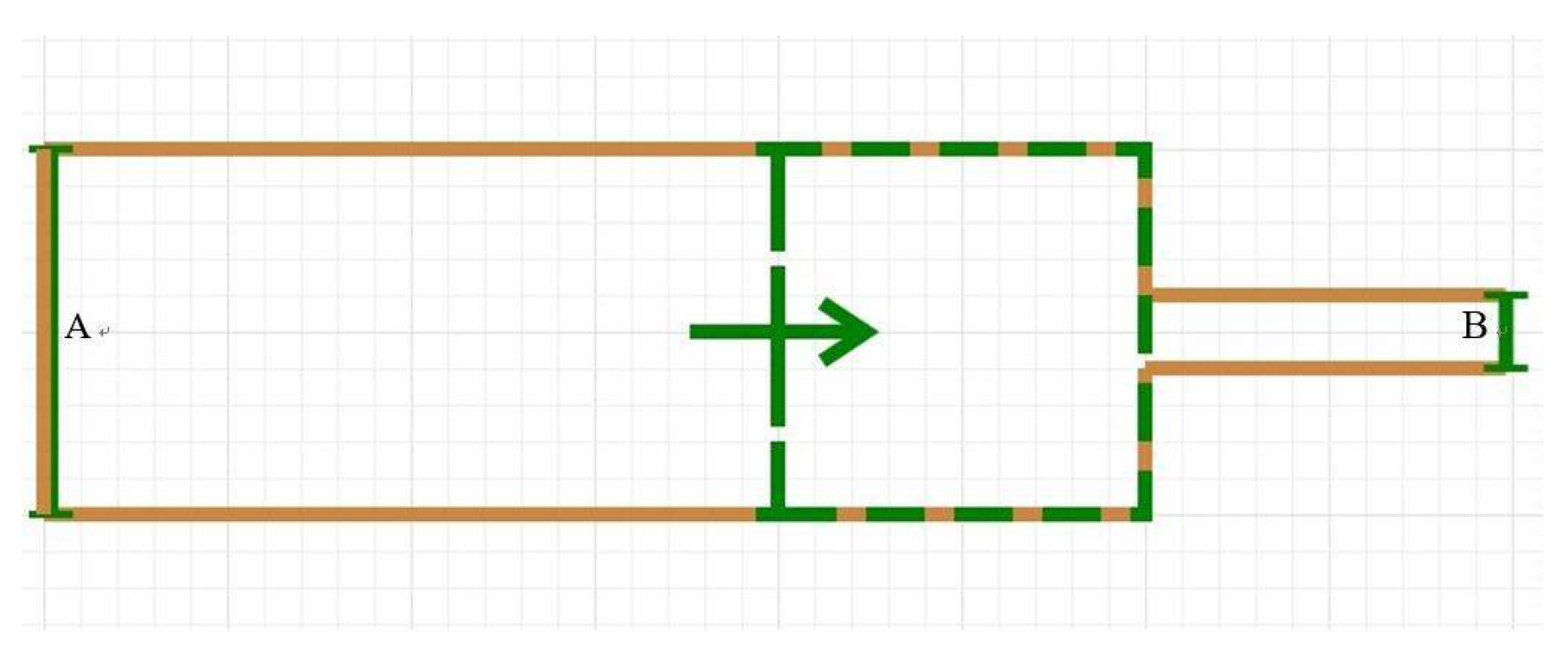
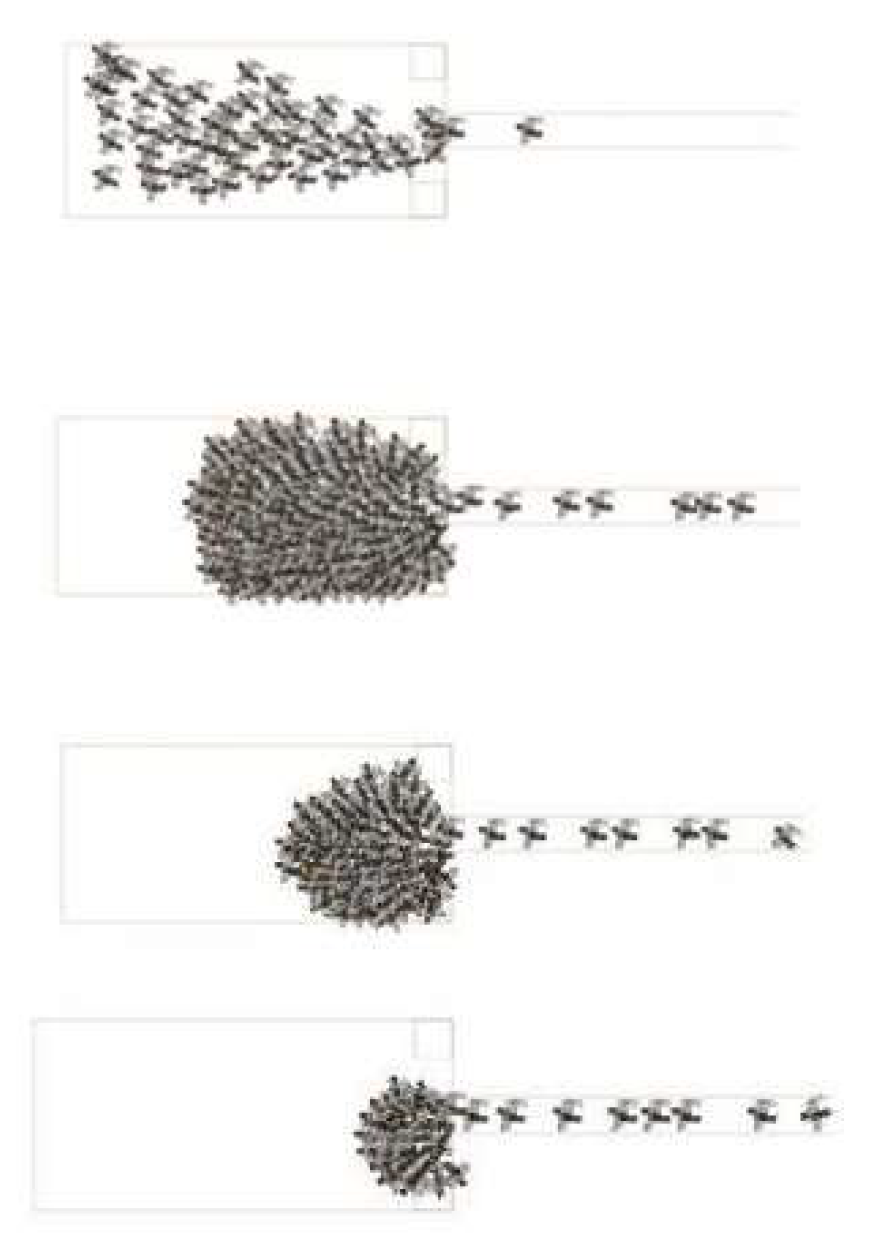
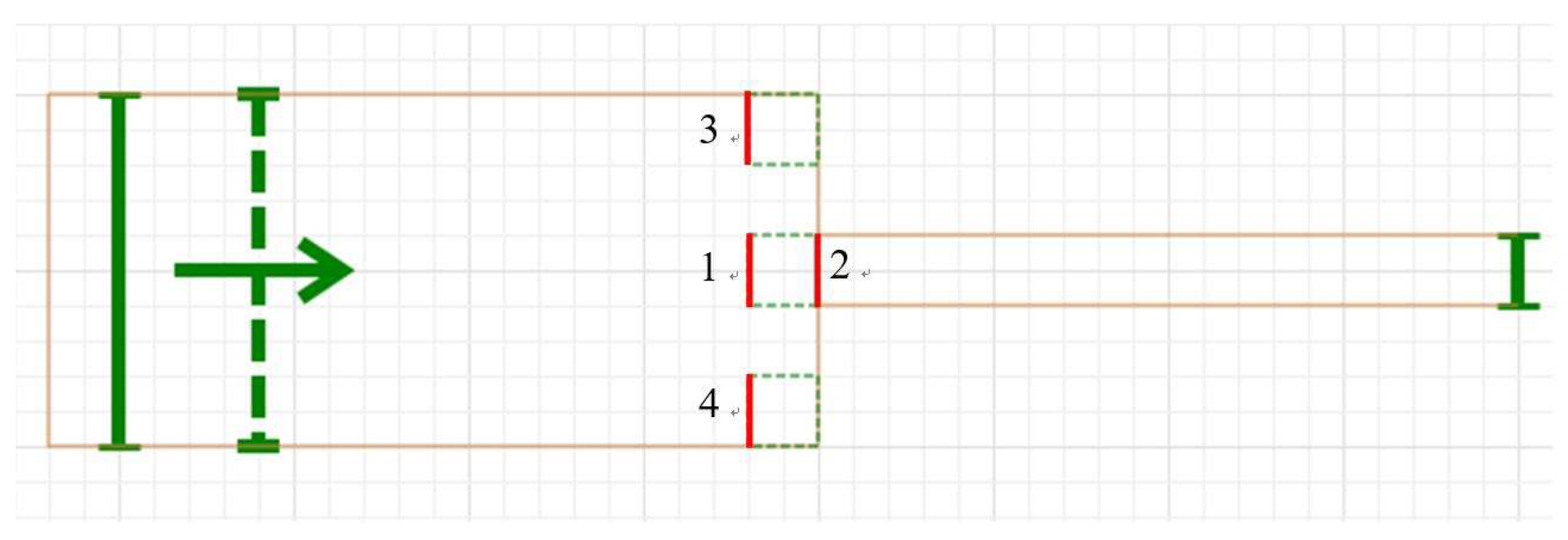
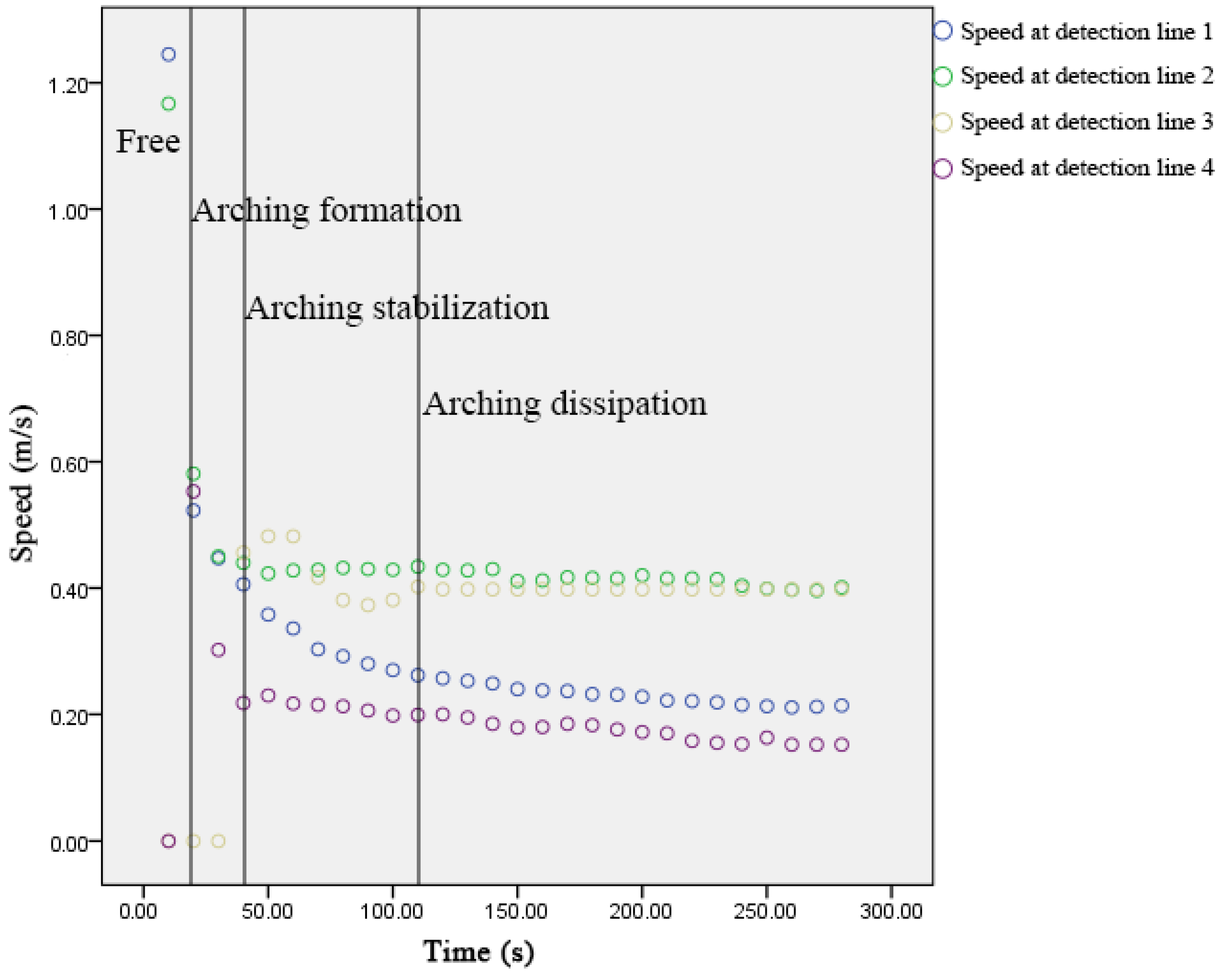

| Cellular Automata Model | Benefit Cost Cellular Model | Magnetic Model | Social Force Model | |
|---|---|---|---|---|
| Principle of walking | Grid | Grid | Coordinate system | Coordinate system |
| Driving force | Define direction | Benefit value of mobile | Anode and cathode magnetic force | Expected speed |
| Influence force | Update rule | Cost value of mobile | Anode and cathode magnetic force | Interaction force |
| Walking space | Discreet | Discreet | Continuous | Continuous |
| Describe the phenomenon | Queuing, self-organization | Queuing | Routing search | Self-organization and evacuation |
| Principia mathematica | Rule based | Optimization objective based | Optimization objective based | Variance based |
| Calibration of model parameters | Analysis of basic data | Observation | Observation | Observation |
| Calibration of model variables | 0 or 1 | Any assignment | Physical significance | Physical significance |
| Programmability | Easy | Easy | Ordinary | Difficulty |
| Grades | Contact Areas | None Contact Areas | Personal Comfort Zones | Actionable Areas |
|---|---|---|---|---|
| Equivalent diameter (m) | 0.235 | 0.457 | 0.533 | 0.609 |
| Passing Time | Width Ratio | Length Ratio | ||
|---|---|---|---|---|
| Pearson’s Correlation | Passing Time | 1.000 | 0.856 | 0.022 |
| Width Ratio | 0.856 | 1.000 | 0.000 | |
| Length Ratio | 0.022 | 0.000 | 1.000 | |
| Sig. (one-tailed) | Passing Time | 0.000 | 0.457 | |
| Width Ratio | 0.000 | 0.500 | ||
| Length Ratio | 0.457 | 0.500 | ||
| N | Passing Time | 27 | 27 | 27 |
| Width Ratio | 27 | 27 | 27 | |
| Length Ratio | 27 | 27 | 27 | |
Publisher’s Note: MDPI stays neutral with regard to jurisdictional claims in published maps and institutional affiliations. |
© 2021 by the authors. Licensee MDPI, Basel, Switzerland. This article is an open access article distributed under the terms and conditions of the Creative Commons Attribution (CC BY) license (https://creativecommons.org/licenses/by/4.0/).
Share and Cite
Luo, W.; Jiao, P.; Wang, Y. Pedestrian Arching Mechanism at Bottleneck in Subway Transit Hub. Information 2021, 12, 164. https://doi.org/10.3390/info12040164
Luo W, Jiao P, Wang Y. Pedestrian Arching Mechanism at Bottleneck in Subway Transit Hub. Information. 2021; 12(4):164. https://doi.org/10.3390/info12040164
Chicago/Turabian StyleLuo, Wei, Pengpeng Jiao, and Yi Wang. 2021. "Pedestrian Arching Mechanism at Bottleneck in Subway Transit Hub" Information 12, no. 4: 164. https://doi.org/10.3390/info12040164
APA StyleLuo, W., Jiao, P., & Wang, Y. (2021). Pedestrian Arching Mechanism at Bottleneck in Subway Transit Hub. Information, 12(4), 164. https://doi.org/10.3390/info12040164







